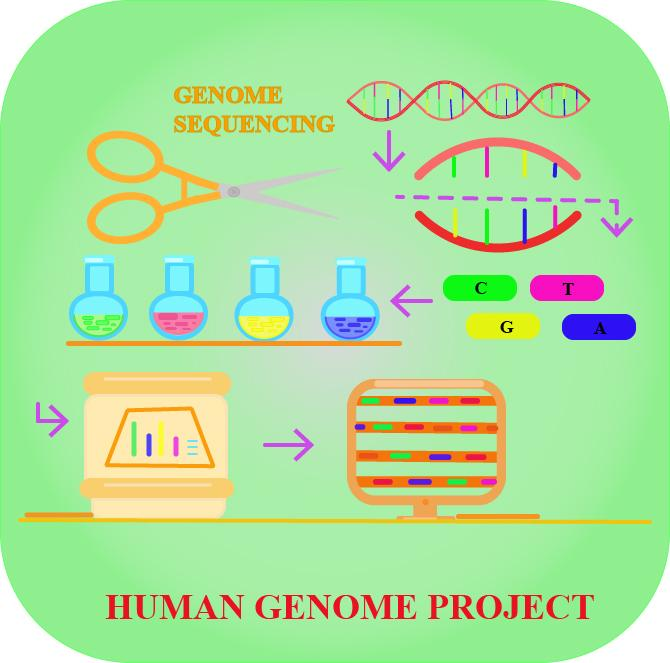
Write four goals for the Human Genome Project.
Answer
569.1k+ views
Hint: The Human genome project (HGP) was an enormous project that focused on arranging every base in the human genome. This project has yielded much new information. Many new areas and avenues have opened as a consequence of the project.
Complete answer:
Goals of the Human Genome Project are –
-Optimization of info analysis.
-Sequencing the whole genome.
-Creating genome sequence databases to store the information.
-Identification of the entire human genome.
-Taking care of the legal, ethical, and social issues that the project may pose.
Additional Information: Salient Features of Human Genome are-
-The human genome contains 3164.7 million base pairs.
-The typical gene consists of 3000 bases, but sizes vary greatly, with the most important known human gene being dystrophin at 2.4 million bases.
-Over 50 percent of the discovered genes, their function is unknown.
-Only 2 percent of the genome codes for proteins.
-Repeated sequences structure a very large portion of the human genome.
-Repetitive sequences are stretches of DNA sequences that are repeated repeatedly, sometimes hundred to thousand-fold. They are concepted to possess no direct coding functions, but they learn-to light on chromosome structure, dynamics, and evolution.
-Chromosome 1 has the most genes (2968), and therefore the Y has the fewest (231).
Note: As the goals of the human genome project were achieved, it led to great advancement in research. Today, if any disease arises due to some alteration during a certain gene, then it might be traced and compared to the genome database that we have already got.

Complete answer:
Goals of the Human Genome Project are –
-Optimization of info analysis.
-Sequencing the whole genome.
-Creating genome sequence databases to store the information.
-Identification of the entire human genome.
-Taking care of the legal, ethical, and social issues that the project may pose.
Additional Information: Salient Features of Human Genome are-
-The human genome contains 3164.7 million base pairs.
-The typical gene consists of 3000 bases, but sizes vary greatly, with the most important known human gene being dystrophin at 2.4 million bases.
-Over 50 percent of the discovered genes, their function is unknown.
-Only 2 percent of the genome codes for proteins.
-Repeated sequences structure a very large portion of the human genome.
-Repetitive sequences are stretches of DNA sequences that are repeated repeatedly, sometimes hundred to thousand-fold. They are concepted to possess no direct coding functions, but they learn-to light on chromosome structure, dynamics, and evolution.
-Chromosome 1 has the most genes (2968), and therefore the Y has the fewest (231).
Note: As the goals of the human genome project were achieved, it led to great advancement in research. Today, if any disease arises due to some alteration during a certain gene, then it might be traced and compared to the genome database that we have already got.

Recently Updated Pages
A man running at a speed 5 ms is viewed in the side class 12 physics CBSE

The number of solutions in x in 02pi for which sqrt class 12 maths CBSE

State and explain Hardy Weinbergs Principle class 12 biology CBSE

Write any two methods of preparation of phenol Give class 12 chemistry CBSE

Which of the following statements is wrong a Amnion class 12 biology CBSE

Differentiate between action potential and resting class 12 biology CBSE

Trending doubts
What are the major means of transport Explain each class 12 social science CBSE

Which are the Top 10 Largest Countries of the World?

Draw a labelled sketch of the human eye class 12 physics CBSE

Explain sex determination in humans with line diag class 12 biology CBSE

Explain sex determination in humans with the help of class 12 biology CBSE

Differentiate between homogeneous and heterogeneous class 12 chemistry CBSE




